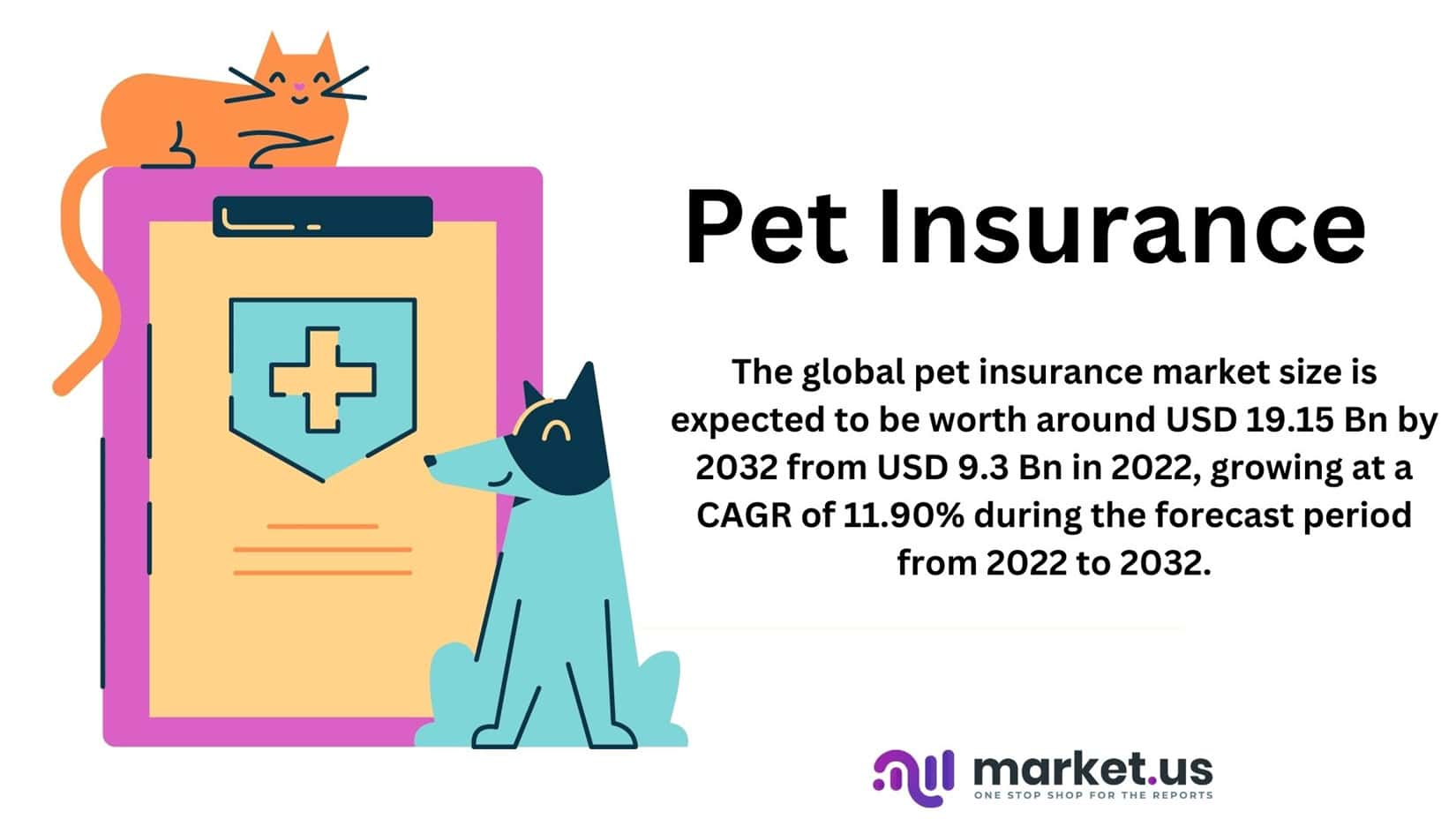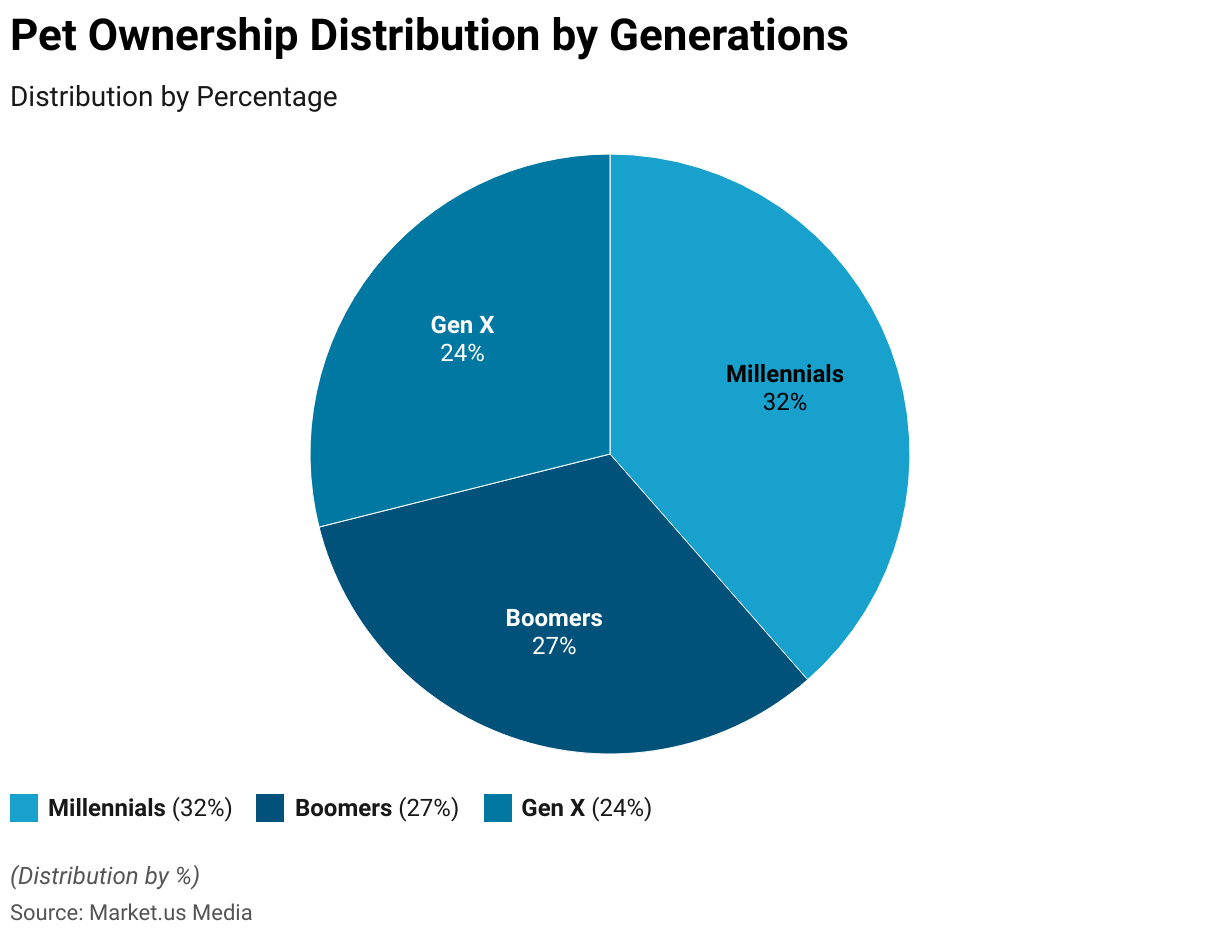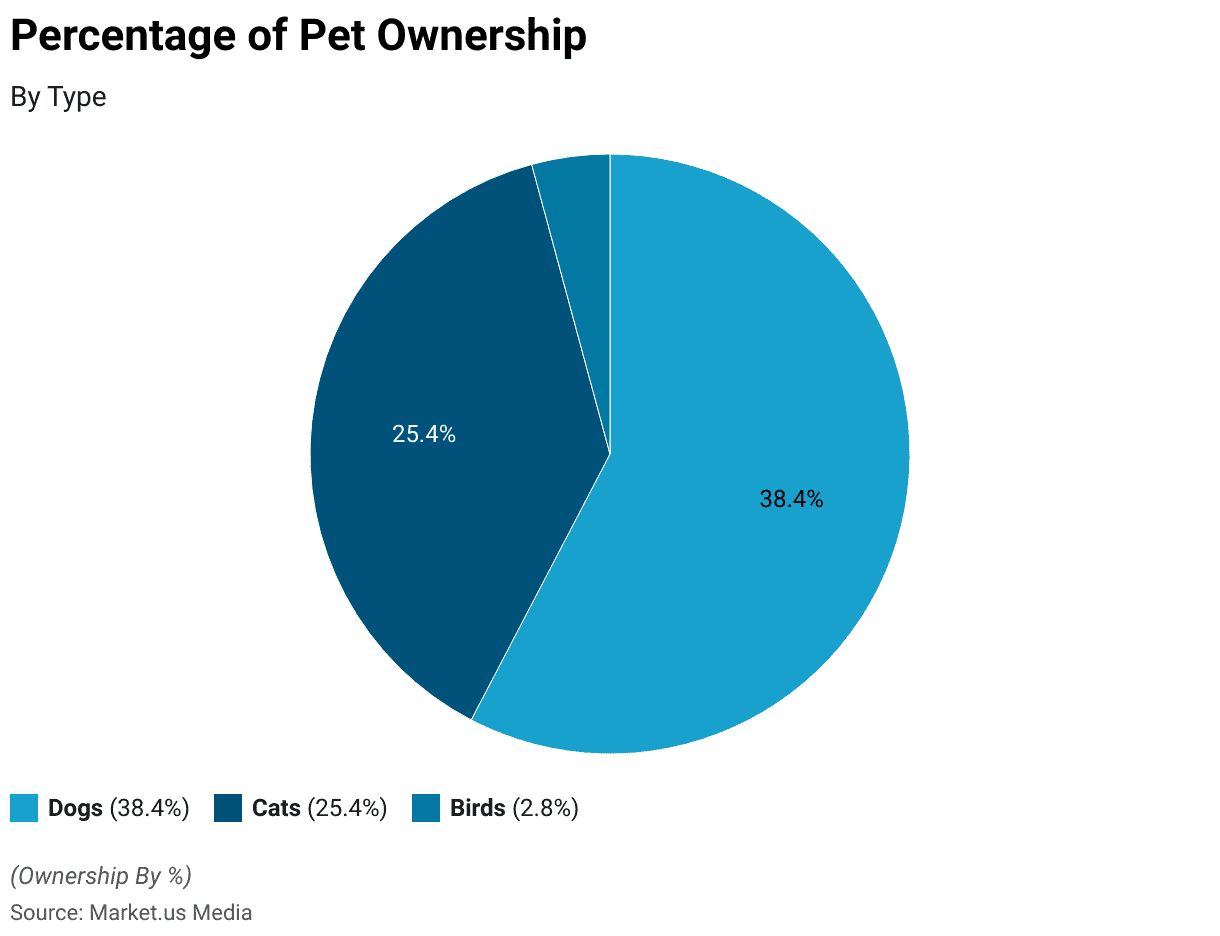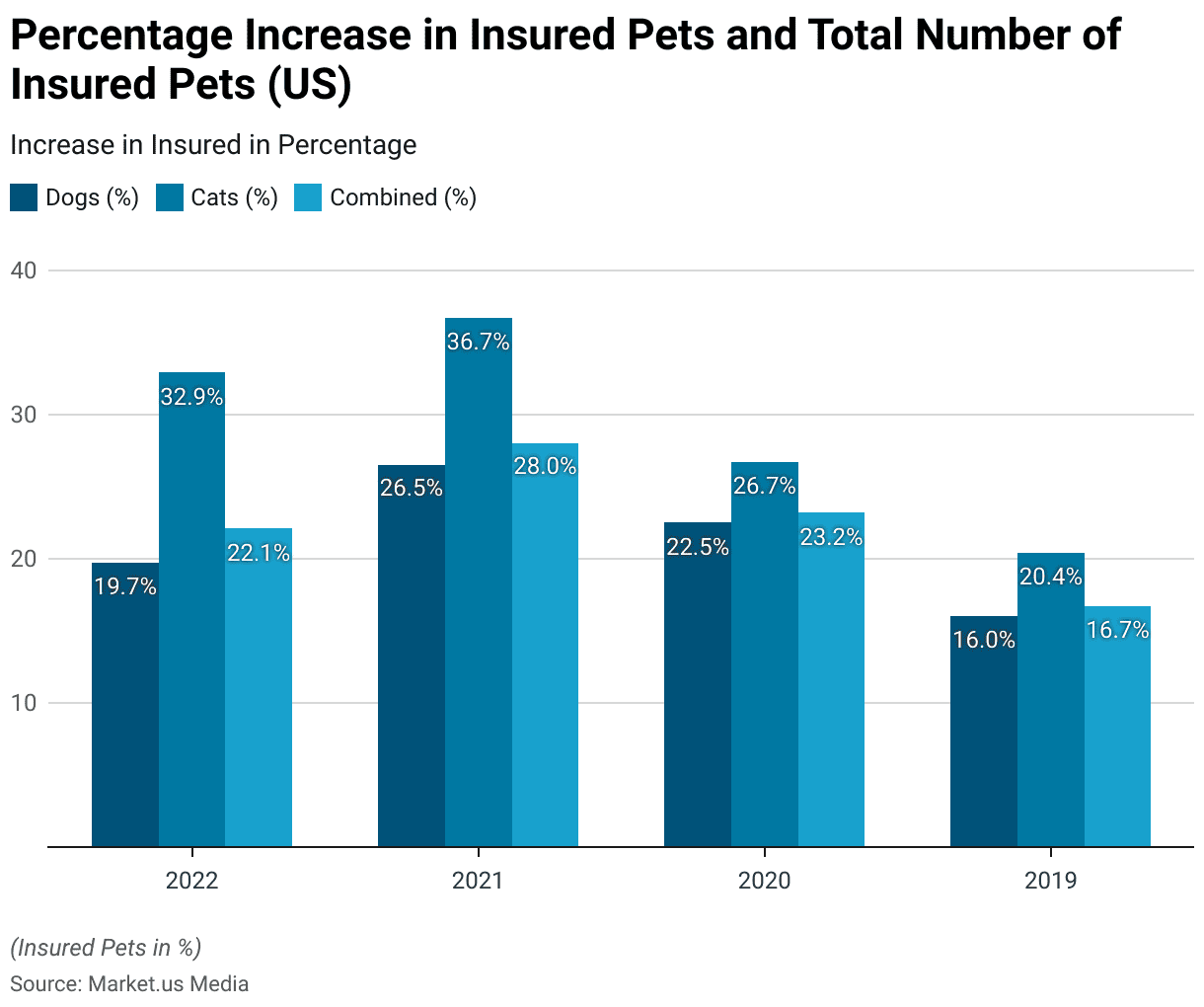Table of Contents
- Introduction
- Editor’s Choice
- Pet Insurance Statistics – Pet Insurance Industry
- Pet Insurance Statistics – Penetration and Awareness
- Pet Insurance Statistics – Ownership Demographics
- Pet Ownership, Veterinary Spending, and Insurance Trends Statistics
- Average Costs of Routine Medical Care for Dogs and Cats
- Percentage Increase in Insured Pets Year Over Year (2019-2022) in the US
- Pet Insurance Statistics by Country
- Recent Developments
- Wrap Up
- FAQs
Introduction
Pet Insurance Statistics: Pet insurance is a type of insurance coverage designed to help pet owners manage the costs associated with veterinary care for their pets.
It provides financial protection in case of unexpected accidents, illnesses, or injuries to pets. Just like health insurance for humans, pet insurance policies come with various coverage options, deductibles, and premium rates.

Editor’s Choice
- The global pet insurance market size is expected to be worth around USD 19.15 Bn by 2032 from USD 9.3 Bn in 2022, growing at a CAGR of 11.90% during the forecast period from 2022 to 2032.
- In the United States, approximately 2.7 million pets were insured in 2020, representing around 3% of the total pet population.
- The average annual premium for pet insurance in the United States is around $566 for dogs and $354 for cats.
- According to a survey, 80% of pet owners who filed a claim with their insurance provider were satisfied with the reimbursement process.
- Around 33% of pet owners in the United Kingdom have pet insurance, while in Sweden, the penetration rate is as high as 50%.
(Source: Market.us, American Pet Products Association, Canine Journal, European Pet Insurance Market Report)
Pet Insurance Statistics – Pet Insurance Industry
- At the end of 2021, the United States had 3.9 million insured pets, marking a 28% increase compared to 2020.
- The pet insurance industry in the United States experienced impressive growth over the past four years, more than doubling in size and generating sales of over $2.83 billion by the end of 2021.
- In 1982, the first dog to ever be insured in the United States was the famous TV character Lassie.
- The COVID-19 pandemic played a role in the growth of the pet industry, with a 26% increase in the sector from 2019 to 2020.
- The pet insurance marketplace in the United States consists of 25 companies.
- In the United States, over half of households, which translates to 70% or 90.5 million homes, own a pet.
- Pet insurance premiums in Canada reached a total of $313.4 million in 2021.
- On average, pet insurance premiums amount to $585.40 per year for dogs and $349.94 for cats.
- California has the highest number of insured pets in the United States, accounting for 19.2% of the total.
- California, New York, Florida, New Jersey, and Texas together represent over 45% of the pet insurance policies in the United States.
- In the United States, dogs account for 82% of insured pets, while cats make up the remaining 18%.
- The top five most common pet insurance claims in 2021 were related to skin issues, gastrointestinal issues, ear infections, seizures, and urinary tract infections.
- Every six seconds, a pet owner receives a vet bill exceeding $1,000.
(Source: hepper)
Pet Insurance Statistics – Penetration and Awareness
- In the United States, approximately 3% of the total pet population was insured in 2020.
- Around 33% of pet owners in the United Kingdom have pet insurance.
- In Sweden, the penetration rate for pet insurance is as high as 50%.
- According to a survey conducted in the United States, around 68% of pet owners were aware of pet insurance in 2020.
- In the United Kingdom, a survey revealed that approximately 78% of pet owners were aware of pet insurance and its benefits.
- A study conducted in Australia found that 32% of pet owners had a good understanding of pet insurance, while 45% had some understanding but were not fully informed.
(Source: European Pet Insurance Market Report, North American Pet Health Insurance Association, Mintel Pet Insurance UK Report)
Pet Insurance Statistics – Ownership Demographics
By Generations
- Millennials make up 32% of all pet owners. This means that a significant portion of the pet ownership population belongs to the millennial generation.
- Boomers account for 27% of pet owners. Despite being a slightly smaller percentage than millennials, boomers still represent a significant portion of the pet-owning demographic.
- Gen X comprises 24% of all pet owners. This generation, sandwiched between millennials and boomers, also holds a substantial share of the pet ownership population.
(Source: Money)

By Species
- Dogs account for 38.4% of pet ownership, making them the most popular choice among pet owners.
- Cats are the second most commonly owned pets, with a percentage of 25.4%.
- Birds represent a smaller portion of the pet population, with only 2.8% of households owning them as pets.
(Source: Money)

Pet Ownership, Veterinary Spending, and Insurance Trends Statistics
- 70% of households in the U.S., which is approximately 151.1 million households, reported owning a pet.
- Estimated spending on vet care and products (excluding food and treats) in 2021 is $32.3 billion, up from $31.4 billion in 2020.
- Consumer spending on pet medical care has consistently risen every year since 2001.
- The total number of pets insured in 2022 reached 5.3 million, up from 3.1 million in 2020.
- Dogs make up 80.1% of insured pets, while cats make up 19.9%.
- As the lifespans of companion animals increase, veterinary care costs are likely to rise for consumers.
- In the U.S., 92.8% of insured pets are covered by Accident & Illness plans or Embedded Wellness plans, 7% have Endorsements (such as wellness or cancer treatments), and the remaining 0.2% have Accident Only plans.
(Source: Center of Insurance Policy and Research)
Average Costs of Routine Medical Care for Dogs and Cats
Routine Medical Costs
- For dogs, the average annual cost for routine medical expenses is approximately $225.
- For cats, the average annual cost for routine medical expenses is around $160.
Preventative Medication
- Dogs require an average of $185 per year for preventative medications.
- Cats need approximately $140 per year for preventative medications.
Spay/Neuter
- The average cost for spaying or neutering a dog is $300.
- For cats, the average cost for spaying or neutering is $150.
Initial Medical Costs
- Dogs typically have initial medical costs of about $300, which includes vaccinations, examinations, and other necessary medical procedures.
- Cats have initial medical costs of approximately $150, covering similar procedures like vaccinations and examinations.
Dental
- Dog owners spend an average of $500 on dental care for their pets.
- Cat owners, on the other hand, allocate around $700 for dental treatments.
(Source: Money)

Percentage Increase in Insured Pets Year Over Year (2019-2022) in the US
- In 2022, there was a 19.7% increase in the number of insured dogs compared to the previous year. Additionally, the number of insured cats increased by 32.9%. Overall, there was a 22.1% increase in the combined number of insured pets. The total number of insured pets in the United States reached 4,849,540.
- In 2021, there was a significant 26.5% increase in the number of insured dogs compared to the previous year. The number of insured cats also experienced a substantial growth of 36.7%. In total, the combined number of insured pets increased by 28.0%, reaching a total of 3,970,535 pets.
- In 2020, there was a 22.5% increase in the number of insured dogs compared to the previous year. The number of insured cats also saw a notable growth of 26.7%. Overall, the combined number of insured pets increased by 23.2% compared to the previous year, totaling 3,101,956 pets.
- In 2019, there was a 16% increase in the number of insured dogs compared to the previous year. The number of insured cats also experienced a growth of 20.4%. In total, the combined number of insured pets increased by 16.7% compared to the previous year, reaching a total of 2,517,122 pets.
(Source: naphia)

Pet Insurance Statistics by Country
The United States
- In the United States, approximately 2% of the estimated 87.9 million dogs in the nation are insured, totaling around 3.1 million insured pets.
- The overall premium volume for pet insurance in the US is $1.56 billion.
- The pet insurance industry in the US has grown at an average annual rate of 22.1% over the last five years.
Canada
- In Canada, there are 352,631 insured pets as of 2020, with dogs accounting for 75.2% of the total (265,179).
- The number of insured canines in Canada has increased by 13% annually, which is the highest growth rate recorded since 2018.
- The total number of insured pets in North America, including both the US and Canada, is 3.45 million.
The United Kingdom
- In the United Kingdom, it is estimated that over 45% of households have a pet, with a total of 8.1 million dogs and 8 million cats.
- There are 4.8 million insured pets in the UK, representing a penetration rate of about 25%.
- Among the insured pets, there are 1.3 million cats, 2.8 million dogs, and 700,000 other species covered by pet insurance.
- Pet insurance claims in the UK have increased by 75% over the past ten years, resulting in record-breaking payouts. British pet insurance firms pay out approximately 2.2 million GBP in claims daily.
Sweden
- In Sweden, there are over a million pet dogs, and about 90% of them are insured.
- The average annual cost of dog insurance in Sweden is $536, and pet insurance has been available in the country since 1924.
- Sweden has a strong culture of animal care, and animals are considered part of the family.
Australia
- Australia has one of the highest pet ownership rates globally, with 62% of households having a pet, totaling 29 million animals.
- Pet insurance spending in Australia has increased by 56% over the previous three years.
- However, only 7.1% of the 5.4 million owned dogs in Australia, which is approximately 383,400 dogs, are covered by pet insurance.
Recent Developments
Market Expansion and Growth:
- The pet insurance market has experienced significant growth, with an increasing number of pet owners opting for insurance coverage to mitigate veterinary care costs.
- Market research reports indicate that the global pet insurance market is projected to reach billions of dollars in revenue.
Acquisitions and Mergers:
- Leading pet insurance companies have engaged in acquisitions and mergers to expand their market presence, enhance product offerings, and gain access to new customer segments.
- Recent mergers and acquisitions within the pet insurance industry.
New Product Launches and Innovations:
- Pet insurance providers have introduced new insurance plans and policy options tailored to meet the evolving needs of pet owners, including coverage for preventive care, wellness services, and alternative therapies.
- Innovative features such as customizable coverage, online claims processing, and mobile app integration have been rolled out to improve customer experience and accessibility.
Partnerships with Veterinary Clinics and Retailers:
- Pet insurance companies have formed partnerships with veterinary clinics, pet stores, and online retailers to promote insurance coverage and facilitate enrollment for pet owners.
- Collaborative efforts aim to raise awareness about the importance of pet insurance and streamline the claims process for policyholders.
Investment and Funding:
- Venture capital firms and investors have shown interest in the pet insurance sector, providing funding and capital injections to support market expansion, technological advancements, and product innovation.
- Funding rounds and investments in pet insurance startups and technology platforms have contributed to the growth and competitiveness of the industry.
Consumer Education and Awareness Campaigns:
- Pet insurance companies have launched educational initiatives and marketing campaigns to increase awareness about the benefits of pet insurance and address common misconceptions.
- Efforts to educate pet owners about the value of insurance coverage for unexpected veterinary expenses aim to drive adoption and market penetration.
Regulatory Developments and Compliance:
- Regulatory agencies have introduced guidelines and standards to ensure transparency, fairness, and consumer protection within the pet insurance industry.
- Compliance with regulatory requirements and adherence to best practices are essential for pet insurance companies to maintain trust and credibility among policyholders.
Wrap Up
Pet Insurance Statistics – Pet Insurance displays that pet insurance has seen significant growth and increasing popularity in several countries. While the penetration rates vary, more pet owners are recognizing the value of pet insurance in providing financial security and peace of mind when it comes to their beloved companions’ healthcare.
The industry has witnessed steady expansion, with the number of insured pets rising in countries like the United States, Canada, the United Kingdom, Sweden, and Australia. As consumer awareness and understanding of pet insurance continue to improve, the demand for coverage will likely continue to increase, resulting in a promising future for the pet insurance industry.
FAQs
Pet insurance is a type of insurance coverage that helps pet owners manage the costs of veterinary care for their pets. It typically covers expenses related to accidents, illnesses, and sometimes routine care.
As of 2020, the North American Pet Health Insurance Association (NAPHIA) reported a total of 3.45 million insured pets in North America, including the United States and Canada.
The global pet insurance market size is expected to be worth around USD 19.15 Bn by 2032 from USD 9.3 Bn in 2022, growing at a CAGR of 11.90% during the forecast period from 2022 to 2032.
Sweden is known for its high pet insurance penetration rate, with approximately 90% of pet dogs being insured. The United Kingdom also has a relatively high penetration rate, with around 25% of pets being insured.
Discuss your needs with our analyst
Please share your requirements with more details so our analyst can check if they can solve your problem(s)



